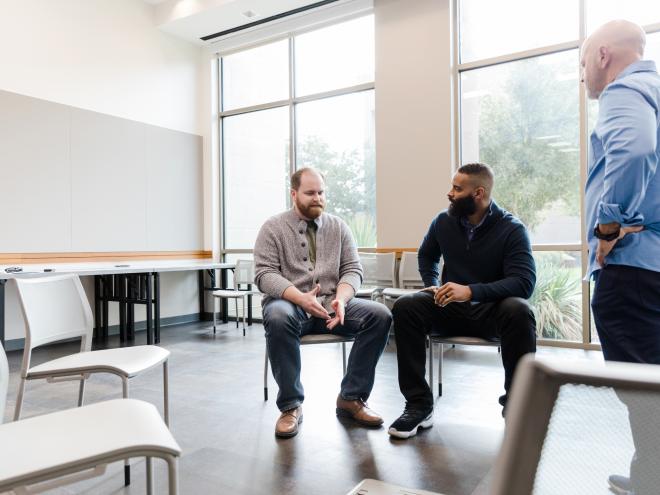 Business Pathways welcomes guest writer, Cherolyn Knapp. Cherolyn is a lawyer, conflict resolution consultant, mediator, workplace investigator, and the founder of Knapp Resolutions which offers tailor-made conflict and dispute resolution processes and training for workplaces, organizations, and businesses across BC.
Business Pathways welcomes guest writer, Cherolyn Knapp. Cherolyn is a lawyer, conflict resolution consultant, mediator, workplace investigator, and the founder of Knapp Resolutions which offers tailor-made conflict and dispute resolution processes and training for workplaces, organizations, and businesses across BC.
Register now for a Business Pathways webinar hosted by Cherolyn, “Foundational strategies for managing bullying and harassment in your practice" on Tuesday, February 13, 2024 from 5:30-6:30 p.m.
Additional webinar information is below.
You’ve probably been there.
A conflict with a co-worker has escalated so far out of hand that you are no longer able to have a productive conversation about the work you need to complete. Your attempts to express yourself seem to fall on deaf ears; the conversation either blows up or gets shut down. You start to feel unsafe or that there is no point in trying to see eye-to-eye anymore.
You may be thinking: Why has it becoming impossible to talk about the issue? Why are my feelings going unacknowledged? Why am I not being heard? Though conflict may be initially viewed as just a disagreement over a singular issue, there are usually far more complex, multilayered dynamics at play. In my conflict resolution practice, I usually get involved when people are no longer able to talk to each other.
Many people lose sight of the fact that conflict is a necessary and healthy characteristic of an innovative, creative team. Diverse perspectives will arise from people who have different backgrounds, lifestyles, training, or life experience. Equipped with the right processes and proficient navigation of the emotions of oneself and others, these rich differences can translate into an ability to generate creative, innovative ideas. But without, it can contribute to a psychologically and mentally unhealthy workplace.
The fight, flight, or freeze response
As physicians, you understand how the fight, flight, or freeze response to threatening situations functions to keep us safe. It allows us to make snap judgments and act quickly. But the same part of the brain that initiates this response is unable to simultaneously engage in complex processing, problem solving, or nuanced communication skills. It’s common for anyone who experiences a perceived threat to behave in a potentially defensive, aggressive, or withdrawn way. This does not serve us when we try to discuss and solve complex problems.
Identifying, acknowledging, and making space to feel emotions is important to everyone’s well-being. When we are not able to express feelings in a healthy and supported way, those feelings might show up as reactive displays of anger, frustration, or overwhelm.
Shifting mindsets
Given the current nature of health care, where day-to-day situations can feel critical and teams may be operating in reactive state most of the time, how can we support psychologically healthy problem-solving, both personally and professionally?
- Check in with yourself
When you need to engage in a problem-solving conversation, the first step is to check in with yourself about your emotional status. Notice if you are feeling angry or frustrated and also if you are physically agitated. If you are in a reactive/fight-flight-freeze state, you are not ready to engage.
Removing yourself from the situation allows your brain to go through a process of de-escalation, something the body requires to regain access to logical reasoning and quality of judgment. - Feel your feelings
Ask yourself: What do I need to do to regain or maintain my mental well-being? Identifying, experiencing, and releasing your feelings in a psychologically safe way can help return your body and mind to a state of calm. It’s not OK to vent our elevated feelings on others in the workplace. Examples of healthy ways to release your feelings are:- Talking with a close friend.
- Crying in a safe environment.
- Writing in a journal.
- Listening to music.
- Taking 10 deep breaths.
- Access your self-care toolkit
Create a self-care strategy that works for you. It might include deep-breathing, mindfulness, meditation, exercise, or a yoga practice. How can you make space for them in your routine?
Having a baseline self care practice can help you move out of a reactive state more quickly and allow you to engage in problem-solving conversations more readily. - Respect others’ emotional states
Even if you are not in a reactive state, others may be. Signs of reactivity might include:
- Increased speaking volume and intensity.
- Withdrawn body language.
- Minimal or no responses to your attempts to engage.
Nobody should attempt to have a difficult conversation when the other person is not able to engage in a grounded way.
If you think one of you may be in a reactive state, it’s time to pause the conversation and return to it later. You can simply thank the other person for bringing the issue to your attention or for listening to you so far and make plans to connect to continue another time.
The bottom line
Only when we can manage our own emotions can we start effectively problem-solving and getting creative about how to move forward from challenges.
The next time you find yourself in a difficult conversation or situation, remember that your brain is wired to protect you from interactions that might be perceived as threatening. Giving yourself and others space and understanding in these situations can allow you to tackle issues more easily and helps you collaborate even in the most challenging circumstances.
Watch a Business Pathways webinar hosted by Cherolyn Knapp, “Foundational strategies for managing bullying and harassment in your practice,” from Tuesday, February 13, 2024. You can also watch a past webinar from 2023 titled, “Workplace Conflict Resolution Foundations.”
Interested in exploring conflict resolution further? These are some of Cherolyn’s recommendations for further reading:
- Difficult Conversations: How to Discuss what Matters Most, Douglas Stone, Bruce Patton, Sheela Heen (2010)
- No Ego: How Leaders can Cut the Cost of Workplace Drama, End Entitlement, and Drive Big Results, Cy Wakeman (2017)
- The Joy of Conflict Resolution: Transforming Victims, Villains and Heroes and the Workplace and at Home, Gary Harper (2004)
- It’s All Your Fault at Work: Managing Narcissists and other High-Conflict People, Bill Eddy & L. Georgi DiStefano (2015)



